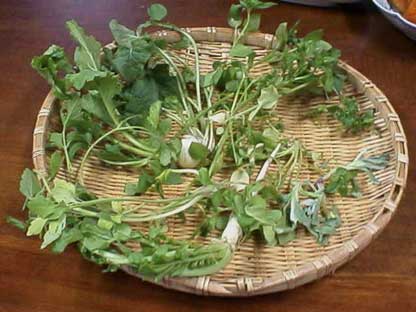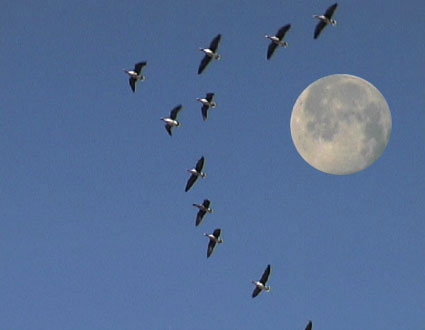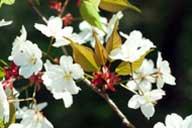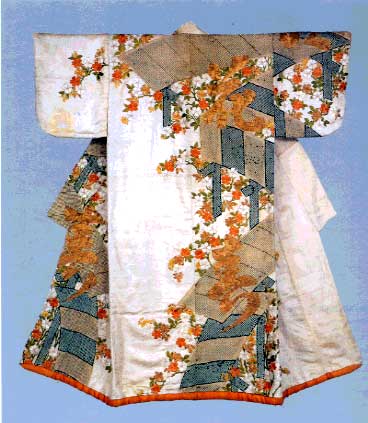OPENING COMMENT
Kokin poems frequently rely on specific images or other sense-derived objects (particularly smells and sounds), some of which only exist in the poetic realm, many of which have a reference in the phenomenal world, especially in "nature". Though many images can be found on the www using search engines by typing, for example, うめ or 梅 for plum blossoms, care needs to be taken because the Kokin era concept may not be exactly the same thing, or, very often, what is conventionally to be imaged when a particular image is evoked is relatively constrained. Thus, for example, in the case of plum, 梅、むめ, it is the white plum, not the red one that is normally what the Kokin poet means to evoke. Or, autumn leaves, 紅葉、もみぢ, which in Kokin times came to mean red autumn leaves refer to yellow autumn leaves in the Manyoshu. I've tried to select graphics and links to sites with the Kokin mentality (as best we understand it) in mind, but please remember not to import exactly what you see back to the Kokin period, assuming an equivalence. These links and such are just a place to start with your poetic imagination.
NOTE: All かな on this page uses 旧仮名遣い、きゅうかなづかい.
WEBSITES FOR GENERAL INFORMATION
**** For the Japanese of all poems go to the Online Japanese Kokin , at the University of Virginia site.
To look for all types of dictionaries and databases (in Japanese) a good link page to start with is Large list of online dictionaries and other databases .
For birds Bird DB Uta (Jse) includes video clips for many, and is easy to navigate. Bird DB Hiraizumi's Birding Page (Jse) is OK, too, has many links, but is a bit old. Go in through the 野鳥図鑑 button, then search first by size. There are also many English language sites, some of which include birds around the world. Bird DB Naturesongs and Greg Kunkel's birdsongs are examples.
For other animals a good starting point is Animal Sounds DB Animal Sounds on the Net .
A so-so online database for plants is the Kyoto Shinbun Digital Shokubutsu En . Don't try searching by month, go in through the 植物検索 button.
THE REMAIINDER OF THIS PAGE IS A COMMENTARY ON SPECIFIC POEMS:
SPRING BOOK ONE, no. 2 "sode hidite ..."
袖ひぢてむすびし水のこほれるを春立つけふの風やとくらん
- sleeves, 袖、そで: Since the poet is cupping water to drink he may be traveling and drinking from a well, or spring, or stream. Therefore, I imagine him not in house-bound court dress but rather in "travel" clothes which, for aristocratic men, meant hunting robes, 狩衣、かりぎぬ. The sleeves are gorgeous, embroidered silk and I think this elegance is meant to be part of the image. See an example: Heian kariginu .
- I've come across a website with personal but thorough thoughts on many Kokin poems. When I think it might be interesting for you to take a look, I'll note it. (Going there is entirely optional, though.) This poem is the first case of that. See Milord Club Kokin Poem 0002 for a diagram of how the various elements of this poem interrelate. This poem is indeed famous for how its various images play off of and reinforce each other.
SPRING BOOK ONE, no. 3 "harugasumi ..."
春霞たてるやいづこみよしののよしのの山に雪はふりつつ
- haze or mist, 霞、かすみ: Kasumi is associated with spring; fog or mist 霧、きり is associated with autumn. Kasumi suggests the moist, romantic, nurturing feeling of spring. It suggests growth, or newness, and a certain sometimes relaxed, sometimes just gentle feeling. I think this photo gets at the mood.
- Yoshino mountains, 吉野、よしの or, very often, み吉野 "the beautiful Yoshino mountains" with the み・御 suggesting almost a sacred aspect. Yoshino was considered deep in the soul/heartland of the Yamato area/spirit. Here is a so-so picture but it does show the mix of mountain cherry trees and other forest trees for which Yoshino is still famous. The photo that had been added to this website under the Genji pages is a little better. Go here.
SPRING BOOK ONE, no. 4 "yuki no uchi ni ..."
雪の内に春はきりけりうぐひすのこほれる涙今やとくらむ
- Japanese bush warbler, 鶯、うぐひす (Cettia diphone): The Japanese warbler was associated with the plum because its mating season is about the time the plum blossoms. It is a very small, charming bird with a truly lovely call. See here.

Japanese bush warbler (uguisu)
- For its song, try uguisusong03 (mp3 file with video clip and comment) or uguisusong01 (mp3 file), but be careful if you are in a library--the song launches immediately!
SPRING BOOK ONE, no. 5 "mume ga e ni ..."
梅がえにきゐるうぐひすはるかけてなけどもいまだ雪はふりつつ
- Plum (blossom) 梅、うめ・むめ . The Kokin poems generally refer to the white plum blossom, though crimson colored blossoms did exist. See Ume Graphic 01 and Ume Graphic 02 and the site Kyoto Plums . Imagine the small warbler among these festive looking blooming branches. Also, note how the poetic conceit of confusing snow with plum blossoms is not so unreasonable a stretch of the imagination.
- This link is strickly for fun. Saibara is a type of folk song. When I was researching saibara songs for my Genji class, I came across this 1946 song based on this Kokin poem. The webpage gives the lyrics while playing the melody. Kind of nice. Go here.
SPRING BOOK ONE, no. 6 "haru tateba ..."
春たてば花とや見らむ白雪のかかれる枝にうぐひすぞなく
- See Milord Club Kokin Poem 0006 for a graphic of how white snow 白雪、しらゆき can be seen as the key image that integrate the others of the poem.
SPRING BOOK ONE, no. 9 "kasumi tachi ..."
霞たちこのめもはるの雪ふれば花なきさとも花ぞちりける
- new leaves 木の芽、このめ. The new leaves or leaf buds on trees in early spring. Notice how 木 is pronounced こ. This is the usual pronunciation for "tree" in waka poems.
- A series of pictures taken over twelve months of the same trees in Kyoto gives a good sense for the pace of seasons there. Go here. The tree buds 木の芽、このは picture is the one for 四月. Remember, waka works with the lunar calendar--"first month" is approximately the first or second week of Feburary (in other words, add 4-6 weeks to the lunar calendar to arrive at an approximately correct "Western" calendar date).
SPRING BOOK ONE, no. 18 "kasugano no ..."
かすがののとぶひのの守いでて見よ今いくかありて若菜つみてむ
- The Kasuga Field 春日野、かすがの is near one of the most important Shinto shrines for the imperial family, located in Nara, and so should be read as having a little extra impact in a poem. I'm posting a picture but, as the original website properly explains, it should be imagined as a wooded area with some open space, not the grassy fields of this photo. Todai Temple 東大寺 is in the background, and was physically present in nearly identical form in the Kokin period, too.
- young sprouts 若菜、わかな. A generic name for the seven grasses 七草、ななくさ, the seven newly spouting herbs gathered on the 7th day of the 1st month, to be eaten for well-being. I came across a description (and recipe!) of the seven herbs on the Tokyo Gas culture page. It has little diagrams that are rather accurate. But go here only if you're interested.
SPRING BOOK ONE, no. 26 "aoyagi no ..."
あをやぎのいとよりかくる春しもぞみだれて花のほころびにける
- The willow 柳、やぎ (today almost always pronounced やなぎ) --or here green willow 青柳、あをやぎ--was planted alternately with sakura trees along the grand avenue that led to the entrance of the Imperial Palace (and elsewhere of course). It was appreciated for the suppleness of its branches (called in poetry threads いと), often associated with women, and the new green of its leaves in early spring.
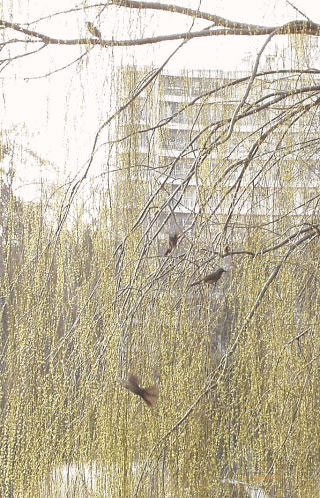
Early spring willow (yagi, yanagi)
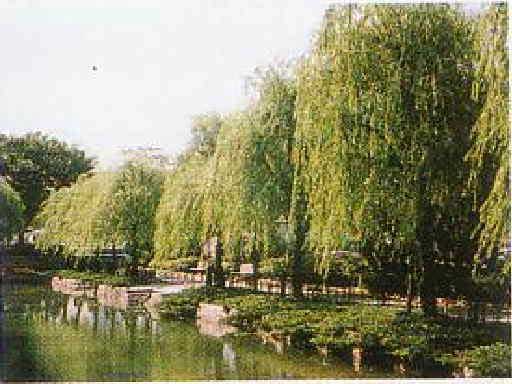
Riverside willow (yagi, yanagi), its typical growing environment
- The willow was considered courtly and elegant. While the following photo is of a Chinese garden (and it is later in the year than this poem no. 26 because the hydrangea, 紫陽花、あぢさゐ are in bloom), it does convey something of this courtliness. (Warning: pic is accompanied with music.) Go here.
(This is a nice site for photographs, by the way--check out the home page if you want.)
SPRING BOOK ONE, no. 29 "ochikochi no ..."
をちこちのたづきもしらぬ山なかにおぼつかなくもよぶ小鳥かな
- While this poem only says small birds 小鳥、こどり and so does not explicitly use the word lesser cuckoo / Oriental cuckoo 時鳥、ほととぎす (Cuculus poliocephalus) and common cuckoo 郭公、かっこう (Cuculus canorus) it is probably refering to these types of birds that flit around in the woods very songfully in the spring: Hototogisu video and song (look in the left-hand frame for ホトトギス ビデオ 300k), more hototogisu songs, kakko video and song (look in the left-hand frame for カッコウ ビデオ 192k), kakko song (sound launches immediately).
- The hototogisu is associated in some myths and stories, and poems, as a messenger for lonely souls in the world of the dead. That nuance is not operative in this poem.

Lesser cuckoo (hototogisu) in its typically wooded environment
(original page here --
photographer expresses some doubt as to whether this is indeed a hototogisui but it is)

Common cuckoo (kakko), photo ゥ by Mike Danzenbaker (original page here)
SPRING BOOK ONE, no. 31 "harugasumi ..."
はるがすみたつを見すててゆくかりは花なき里にすみやならへる
- Wild geese 雁、かり are drawn upon for imagery in both spring and autumn poems because of their migration patterns. Here they are "returning" (帰る) to their summer home. (They were considered to visit the capital with their home ground -- 里 -- somewhere north at the edge of the world, in a flowerless realm.)
- The cry of geese is often mentioned in poetry as well, generally is a distant (skyward) sound, and considered intensely emotional--urgent and/or lonely. While we need not limit the broad term kari to a particular bird species, one common migratory goose of that area is the White-fronted goose マガン. Its cry is here.
SPRING BOOK ONE, nos. 49 - 68
- Poems about cherry blossoms 桜、さくら・桜花、さくらばな・花、はな begin here and continue to the end of Book One. As mentioned in class, imagine the mountain cherry 山桜、やまざくら in nearly all cases for these poems. 山桜 leaf out at the same time that they bloom, so the effect is somewhat different. They grow assymetrically and mixed with other trees. Below is a closeup. There are pictures of the trees blooming in the hills under SPRING BOOK ONE, no. 60.
SPRING BOOK ONE, no. 56 "miwataseba ..."
みわたせば柳桜をこきまぜて春の錦なりける
- The idea behind this poem is to refresh the poetic metaphor of brocade 錦、にしき that had long been associated with autumn by turning the mind to the complex mix of colors that can be seen in spring as well. The poet describes the panorama of blooming cherry trees and freshly green willows. Below is a rather poor picture of an Edo period springtime brocaded kimono. The color set is wrong (since Edo colors are a world away from Heian color schemes), but the idea of complex patterns somewhat randomly mixing to good effect is the image you should have in mind. A number of other brocade examples, of obi, are here: nishiki_pic02.
SPRING BOOK ONE, no. 60 "mi-yoshino no ..."
み吉野の山のべにさけるさくら花雪かとのみぞあやまたれける
- As mentioned elsewhere, here is a so-so picture that shows the mix of mountain cherry trees and other forest trees for which Yoshino is still famous. The photo that had been added to this website under the Genji pages is a little better. Go here.


